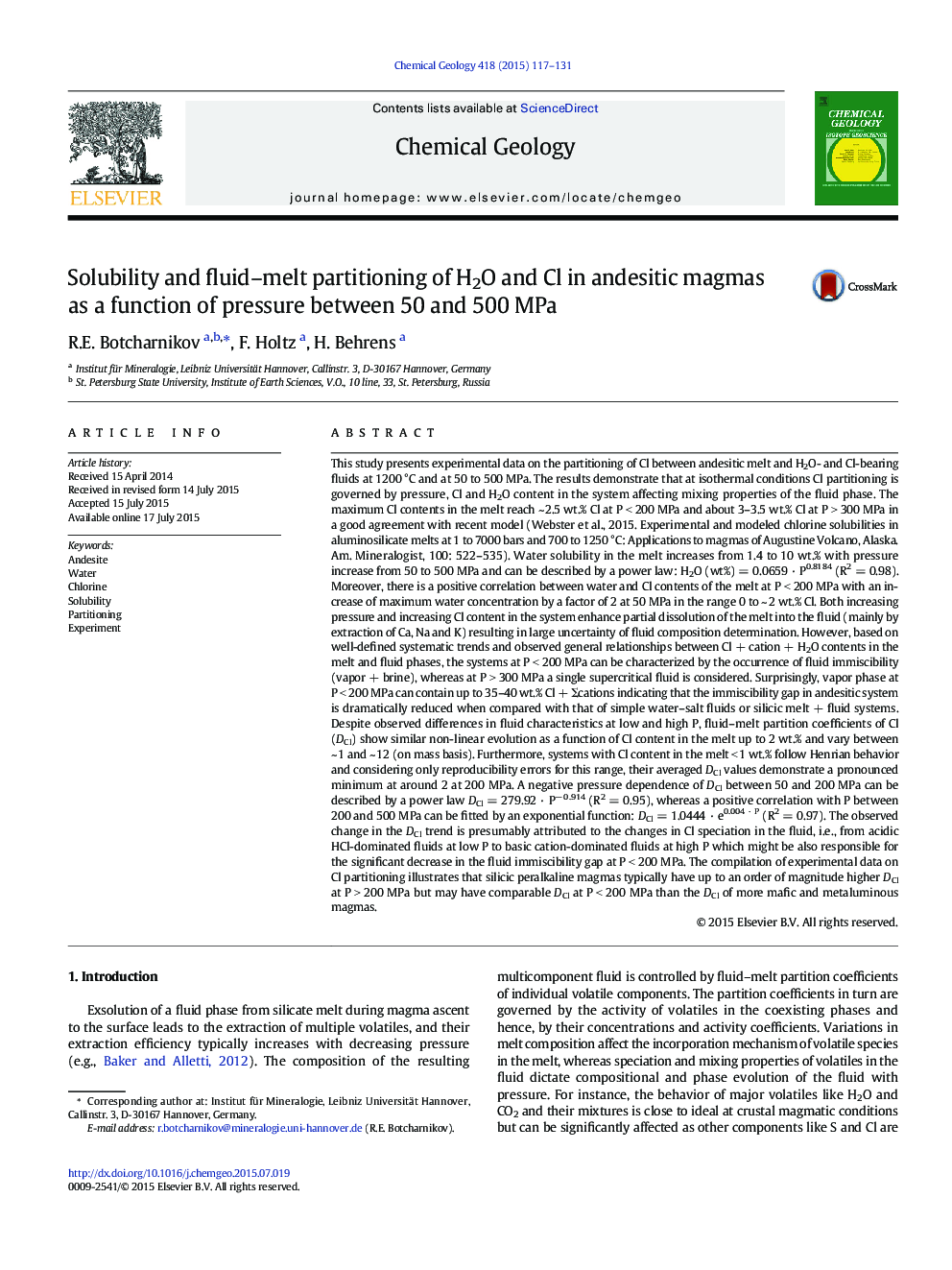| کد مقاله | کد نشریه | سال انتشار | مقاله انگلیسی | نسخه تمام متن |
|---|---|---|---|---|
| 6436202 | 1637556 | 2015 | 15 صفحه PDF | دانلود رایگان |

- Fluid-melt partitioning of Cl is controlled by fluid mixing properties.
- Cl partition coefficient demonstrates a pronounced minimum at 200Â MPa.
- Predominance of HCl at low P can significantly decrease immiscibility gap in fluid.
- Cl increases water solubility in andesitic melt at low pressure.
This study presents experimental data on the partitioning of Cl between andesitic melt and H2O- and Cl-bearing fluids at 1200 °C and at 50 to 500 MPa. The results demonstrate that at isothermal conditions Cl partitioning is governed by pressure, Cl and H2O content in the system affecting mixing properties of the fluid phase. The maximum Cl contents in the melt reach ~ 2.5 wt.% Cl at P < 200 MPa and about 3-3.5 wt.% Cl at P > 300 MPa in a good agreement with recent model (Webster et al., 2015. Experimental and modeled chlorine solubilities in aluminosilicate melts at 1 to 7000 bars and 700 to 1250 °C: Applications to magmas of Augustine Volcano, Alaska. Am. Mineralogist, 100: 522-535). Water solubility in the melt increases from 1.4 to 10 wt.% with pressure increase from 50 to 500 MPa and can be described by a power law: H2O (wt%) = 0.0659 · P0.8184 (R2 = 0.98). Moreover, there is a positive correlation between water and Cl contents of the melt at P < 200 MPa with an increase of maximum water concentration by a factor of 2 at 50 MPa in the range 0 to ~ 2 wt.% Cl. Both increasing pressure and increasing Cl content in the system enhance partial dissolution of the melt into the fluid (mainly by extraction of Ca, Na and K) resulting in large uncertainty of fluid composition determination. However, based on well-defined systematic trends and observed general relationships between Cl + cation + H2O contents in the melt and fluid phases, the systems at P < 200 MPa can be characterized by the occurrence of fluid immiscibility (vapor + brine), whereas at P > 300 MPa a single supercritical fluid is considered. Surprisingly, vapor phase at P < 200 MPa can contain up to 35-40 wt.% Cl + Σcations indicating that the immiscibility gap in andesitic system is dramatically reduced when compared with that of simple water-salt fluids or silicic melt + fluid systems. Despite observed differences in fluid characteristics at low and high P, fluid-melt partition coefficients of Cl (DCl) show similar non-linear evolution as a function of Cl content in the melt up to 2 wt.% and vary between ~ 1 and ~ 12 (on mass basis). Furthermore, systems with Cl content in the melt < 1 wt.% follow Henrian behavior and considering only reproducibility errors for this range, their averaged DCl values demonstrate a pronounced minimum at around 2 at 200 MPa. A negative pressure dependence of DCl between 50 and 200 MPa can be described by a power law DCl = 279.92 · Pâ 0.914 (R2 = 0.95), whereas a positive correlation with P between 200 and 500 MPa can be fitted by an exponential function: DCl = 1.0444 · e0.004 · P (R2 = 0.97). The observed change in the DCl trend is presumably attributed to the changes in Cl speciation in the fluid, i.e., from acidic HCl-dominated fluids at low P to basic cation-dominated fluids at high P which might be also responsible for the significant decrease in the fluid immiscibility gap at P < 200 MPa. The compilation of experimental data on Cl partitioning illustrates that silicic peralkaline magmas typically have up to an order of magnitude higher DCl at P > 200 MPa but may have comparable DCl at P < 200 MPa than the DCl of more mafic and metaluminous magmas.
Journal: Chemical Geology - Volume 418, 15 December 2015, Pages 117-131